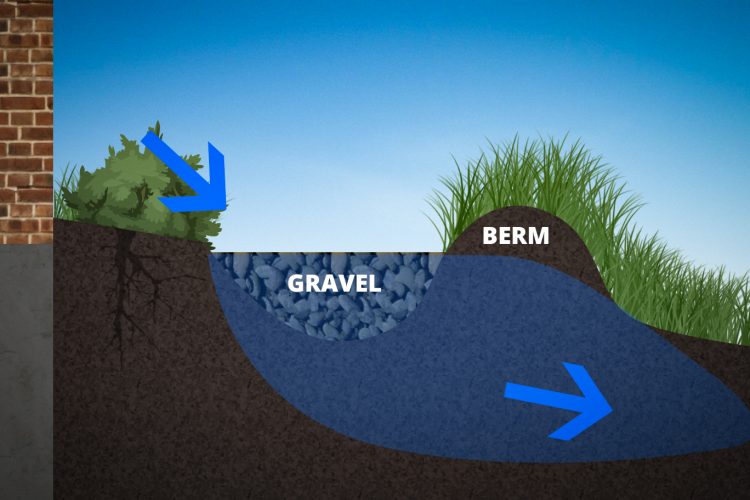
- By admin
- In Landscaping
3 Great Tips For Preventing Puddling And Flooding In Your Landscape
The Old Farmer’s Almanac predicts a mix of light showers and storms from late April until early July. Not only does excessive rain water destroy certain parts of your landscape design, but it can also cause flooding in your home. Thankfully, there are certain things that you can do to reduce this from happening. Here are three landscaping tips on how to prevent puddling and flooding in your yard
1. Create Swales Away from Your House
If you find that the water is often gathering around the base of your home, then you may want to consider creating some manmade swales. A swale is a low tract of land that is created to send the rain water away from your home, instead of towards it. You can create the swale by first creating a berm. A berm is the raised area of land that is at the top of the swale.
You will essentially create your berm by either bringing in new soil, or using extra soil that you have, to create a level, raised border around your home. The water will then run down the berm and into the gravel-filled swale when it rains. To make this as efficient as possible, you want to plant grass, plants, etc. both on the berm and the swale. This helps to ensure that the water is absorbed by the plants when it rains. This also stops the soil from eroding when this a large amount of rain water.
2. Make A Rain Garden
Another great way to help prevent puddling and flooding in your landscape is to create a rain garden. Water will generally gather anywhere that there are depressions in the land. Instead of having these areas turn into muddy pits and depressions filled with water, you can instead turn them into beautiful rain gardens.
A rain garden can incorporate a variety of plants both big and small. You can plant small trees, flowers, bushes, grass, and any other plants you can think of. The more plants in your rain garden, the more water they need to grow and thrive. Thus, decreasing the amount of water that pools in this depression.
3. Incorporate Mulch
Since mulch is usually made from organic materials, such as wood chips, it does an excellent job of absorbing water. In any areas where puddling and flooding is an issue, you should incorporate mulch. Try creating a barrier around your home that is filled with plants with mulch surrounding them. The combination of the mulch and the plants can absorb a great deal of the water. You can also add the mulch in your rain garden, around your trees, in your flower beds, etc.
When it comes to laying the mulch, you want to make it about 2-4 inches deep. This creates enough mulch for absorption. Also, be sure to leave a little bit of room between the roots of your plants and the mulch. This gives the plants plenty of access to water and can help prevent disease.
When it comes to avoiding puddling and flooding in your landscape design, it is very important that you consider adding swales around your home to reroute the water, making a rain garden full of a variety of plants to help absorb some of the water in depressions, and incorporating mulch in areas where flooding is an issue, such as around your house, around trees, and in all plant beds.
Once you decide on your new functional addition to your landscape, use our simple materials calculator to find out how much gravel or mulch you need to complete your project!






35 COMMENTS
Penelope Smith
March 21, 2019, 4:36 am REPLYThis is some really good information about preventing flooding in your landscape. It is good to know that you should think about getting a better rain garden. That does seem like a good thing to be aware of when you want to prevent flooding.
robert griffin
May 27, 2019, 10:01 pm REPLYgreat stuff a wealth of info in an easy to read package. I am buying a home cheap on the water with prone to water issues so I will use these techniques to combat mother nature. With this type of martial art I will divert all enemies to the curb
Benjamin Andrews
May 29, 2019, 4:30 pm REPLYI found it interesting that you state that creating swells the push water away from your house is a good way to eliminate soil erosion. My parents have a large garden want to save their soil from washing away with the rain. I will send them this information so they can look into all their options for erosion prevention.
Jackson Bush
June 25, 2019, 5:31 pm REPLYI think it’s great that mulch can be used as an excellent way of absorbing water. My wife and I recently moved to a new area where it rains a lot. We’re also redoing the front yard and need tips on how to keep it safe from the rain while we remodel. Thank you for the helpful tip, I’ll be exploring my options.
Jay Jorgenson
July 29, 2019, 2:20 pm REPLYI appreciate that you mentioned mulch is usually made from organic materials that absorb water. My dad’s garden gets many puddles during the rainy season. Thank you for the information. I’ll contact a landscaping service so he can get his garden maintained.